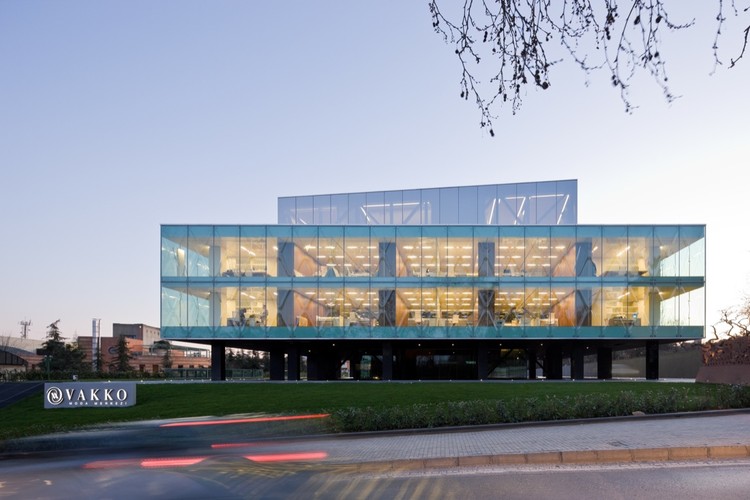
-
Architects: REX
- Area: 9100 m²
- Year: 2010
-
Photographs:Iwan Baan , Cemal Emden
Text description provided by the architects. Last year we presented you this interesting project by REX during its construction stage, where you could see how an unused structure was converted into the new headquarters for Vakko, integrated with a new complex steel structure. The project is now completed, and we can see the final result with photos by Iwan Baan and a complete set of drawings and diagrams courtesy of REX.

Despite the mix of the existing concrete structure with the new additions and the complex inner core (dubbed the "showcase"), the exterior of the building is read as a whole. The structural "X" of the glass panels on the facade break the monotony of the box on the outside, contrasting with the mirror like finish of the volume on top.

The "showcase" fills the central void with a mirror finish that turns the volume into a sculpture (as seen on the photos and on the showcase elevations below), while housing different programs that benefit from the arrange of the boxes, such as the auditorium, meeting rooms and showrooms.
REX once again shows innovative structural solutions in relation with the program, together with new uses of materials as we previously saw on the Wyly Theatre in Dallas.

Program: Headquarters for a Turkish fashion house—including offices, showrooms, conference rooms, auditorium, museum, and dining hall—as well as the television studios, radio production facilities, and screening rooms of its media sister-company
When Caltech’s senior administration suddenly changed REX’s design for the Annenberg Center for Information Science and Technology was canceled.
Two months later, the CEO of Vakko (Turkey’s pre-eminent fashion house) and Power Media (Turkey’s equivalent of MTV) approached REX with plans to design and construct a new headquarters by the year’s end using an unfinished, abandoned hotel. The requested timetable would normally have been absurd. However, the unfinished building fortuitously had the same plan dimension, floor-to-floor height, and servicing concept as the Annenberg Center’s “Ring” (the so-called “Sheep”).

By adapting the Construction Documents produced for the Annenberg Center to the abandoned concrete hotel skeleton, construction on the perimeter office block commenced only four days after Vakko/Power first approached REX. This adaptive re-use opened a six-week window during which the more unique portions of the program could be designed simultaneous to construction. Speed became the design’s most significant parameter.

Whereas the Annenberg Center’s Ring was a fragile, post-tensioned concrete structure which depended upon the robust, steel interior for support, Vakko/Power’s existing Ring is painfully over-designed, the byproduct of numerous, deadly earthquakes in Turkey.
The design problem is therefore reversed: Vakko/Power’s unique interior must remain detached so as not to disrupt the structural integrity and waterproofing of the in situ skeleton. Dubbed the “Showcase,” this unique interior houses the auditorium, showrooms, meeting rooms, and executive offices, as well as all vertical circulation and restrooms.
Meanwhile, the upper floor of the skeleton’s subterranean parking houses Power Media’s television and radio studios, which require acoustic damping and light control.

REX only had two weeks to submit the steel mill order after starting the project. Therefore, a concept for the Showcase was developed that established the general steel shapes and quantities while still allowing the design to evolve significantly.
To this end, REX and its engineers devised steel boxes that could be assembled in myriad configurations while retaining the Showcase’s structural self-sufficiency.
Ultimately, program adjacencies and code/exiting requirements dictated the final stacking of the boxes.

The slopes of the auditorium, showrooms, and meeting rooms create a circulation path that winds from bottom to top of the Showcase.
The Showcase is clad in mirror-glass, creating a “Cabinet of Dr. Caligari” that both repeats and fractures the image of the occupant.
Creating an exceptional new headquarters was critical to maintaining Vakko/Power’s public image; yet, absorption of the clumsy, existing structure was impossible to hide given the time constraints. REX therefore proposed to make the glass façade as thin and immaterial as possible, such that the existing hotel skeleton is exposed, not hidden.

By slumping a structural “X” into each pane, the glass’s strength is increased, its need for perimeter mullions is eliminated, and its thickness is reduced.
The result is an ultra-thin sheath of glass that wraps the existing skeleton. This ethereal “Saran Wrap” subtly reveals the pre-existing concrete skeleton and suggests the Showcase behind.




























































